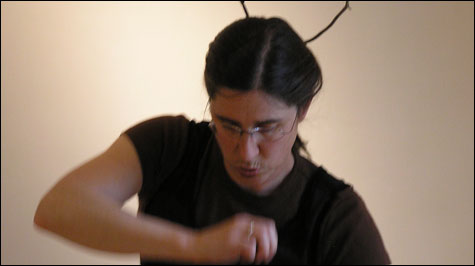
MARJORIE MORGAN Dancing Deborah Hay, she makes her whole body available to what her mind
and imagination suggest every moment. |
Dance history reverberated across Boston during the past few weeks, affirming that how we live now owes a lot to how we’ve chosen to remember — and forget.
As part of the Dance Complex’s Tuesdays at Noon concerts in honor of Dance Month, Marjorie Morgan and Karl Cronin performed works by postmodern dance pioneer Deborah Hay. Boom Boom Boom and The Runner aren’t set dances but interpretations. In workshops with Hay (Morgan attended one in 2000, Cronin in 2007), dancers acquire a set of open-ended instructions they can carry out as they wish. There must be hundreds of ways to get from stage right to stage left in two minutes. Every solution is another dance, individualistic and unrepeatable.

Morgan entered the space crouched over, with branches attached to her head, and in her hands a small baton and a dry-sounding rattle. Like an animal of indeterminate species, or maybe a menagerie of beasts one after the other, she prowled the space. Her attention was riveted on adjusting her balance, moving parts of her body in microscopic but precise directions, registering how every shift made her feel. Her movement and pre-verbal exclamations seemed to be generated by these interior promptings, and each gesture held the seeds of another image.
Marjorie Morgan makes her whole body available to what her mind and imagination suggest every moment. You couldn’t possibly recover the sequence of her journey, or the oddness of her movement, the pleasure and surprise of it, and the dread.
Karl Cronin, a tall, thin young man, wore a knee brace over one trouser leg, and one sock and one bare foot in rubber clogs. His dance was also a succession of ideas, but they seemed almost deliberately chosen, not inevitably connected though unforeseen like Morgan’s. His movement looked less fictitious, more technical — repeated beats of one foot, scuffling walks, wordless syllables, musical phrases in different registers. I decided somewhere in the middle of the dance that his feet were behaving differently from each other, maybe even holding dialogues with each other. It turned out he’d been dancing with an injury.
Deborah Hay, a founder of the legendary Judson Dance Theater in the 1960s, is now based in Austin, where she’s extended the ideas of her early “people dances” into meditative and New Age practices — centering, activating the unpremeditated potential of the body. Judson dance attracted a diverse population of seekers, and Lucinda Childs was a member of that clan. Through their teacher, Robert Dunn, they claimed John Cage as a spiritual mentor for finding alternatives to ballet and modern dance. Ordinary movement, objects, and sounds could be the materials of artmaking; a game or a photograph or a collage could establish the structure for a dance. You could be a trained dancer or a civilian. Hay and Childs have drastically different temperaments and approaches, but the inclusive Judson æsthetic has served them well.
Childs was in town for a showing of a new documentary film about her by French filmmaker and archivist Patrick Bensard. After the Coolidge Corner Theatre screening, a benefit for Green Street Studios, Childs talked with writer Iris Fanger. The film — shot in France, New York, and Martha’s Vineyard, where Childs lives when she’s not on the road — traces a long, unconventional career. Like Deborah Hay and almost all the other Judsonites, Childs didn’t aspire to maintain her own dance company. Although she had an active ensemble of dancers who created her dances of the 1970s, she’s worked as a freelance choreographer, dancer, and actor, mostly in Europe, for the past three decades.
The documentary, with archival clips, performance and rehearsal footage, and thoughtful comments by Childs, centers on three works that represent the phases of her work. Carnation (1964) made a deadpan mockery of women’s preoccupation with domestic objects — kitchen implements, hair curlers — and revealed Childs as a brilliant satirist. Einstein on the Beach (1976) began her association with Robert Wilson and Philip Glass, in the early stages of their immense careers. Dance (1979), with music by Glass and film by Sol LeWitt, created the paradox of “minimalist” choreography framed as a stage spectacle.
Childs and Hay started out with countercultural ideas about stripping away artifice, decadence, sentiment, and ego investment to focus on the basics of performing. Whereas Hay strove for naturalism and freedom to realize one’s own creativity, Childs put stripped-down dance materials into formal patterns dictated by musical structure, with a performing style based on her own reticent, elegant presence.
As later generations absorbed postmodernism, these instincts eventually proliferated again into ego, virtuosity, and excess. Boston Ballet’s final program of the season climaxed with Philip Glass & Twyla Tharp’s 1986 In the Upper Room, an example of minimalism gone backwards — into dazzling audience appeal. For six men and seven women, the dance combines extremes of rigorous form, ongoingness, and pure movement as subject matter. It’s a driven exercise in technique — ballet steps and pointe work, sneaker-clad athleticism — that continually recombines its forces in new ways for 40 minutes and leaves the audience flattened with exhaustion and pleasure.